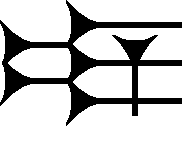
The cuneiform sign for tur is used to denote one syllabic usage, tur, or the sign's Sumerograms; it is used in the Epic of Gilgamesh and the 14th century BC Amarna letters. The sign is based on the i (cuneiform) sign, with the one small added vertical stroke.
Besides tur, it is for Sumerograms (logograms) BÀN, DUMU, and TUR. In the Epic of Gilgamesh, it is used in the following numbers: tur-(11 times), BÀN-(3), DUMU-(25), TUR-(2). The large usage of DUMU in the Epic is for the Sumerogram being the equivalent of "son", Akkadian language "māru".
Amarna letter usage
In the Amarna letters, the topic of Amarna letter EA 296, Under the Yoke, is the guarding of two cities, at the city gate; also the man authoring the letter, Yabitiri-(Yahtiru)-(governor?) of City? gives his history of going to Egypt to be trained with the Pharaoh, EA 296, line 25 (tablet reverse): "... (25) "i-nu-ma TUR a-na-ku", (26) he (Yanhamu) took me to (Egypt) Misri (27)..., (25) "Now when "YOUNG"-(I, myself), (26) he (i.e. Yanhamu) took me to Egypt, (27) ..."
Common text usage
The most common text usage is unlike the digital version. It is composed of 5-horizontals: one (single) above two pairs of two, and all sitting on a large single horizontal stroke, approximated as follows:
It is found in various Amarna letters as part of "Messenger-Xxxxx", for example "LÚ.PA.TUR-Uv-wx-yz"
References
- Parpola, 1971. The Standard Babylonian Epic of Gilgamesh, Sign List, pp. 155-165, no. 144, p. 158.
- Parpola, 1971. The Standard Babylonian Epic of Gilgamesh, Glossary, pp. 119-145, māru, p. 131-132.
- Rainey, 1970. El Amarna Tablets, 359-379, Glossary:Vocabulary, pp. 55-95, sehru-(no. 2)-(small), p. 79; Indexes: II. Sumerograms, TUR, p. 98-99.
- Moran, William L. 1987, 1992. The Amarna Letters. Johns Hopkins University Press, 1987, 1992. 393 pages.(softcover, ISBN 0-8018-6715-0)
- Parpola, 1971. The Standard Babylonian Epic of Gilgamesh, Parpola, Simo, Neo-Assyrian Text Corpus Project, c 1997, Tablet I thru Tablet XII, Index of Names, Sign List, and Glossary-(pp. 119–145), 165 pages.
|
|
This writing system–related article is a stub. You can help Misplaced Pages by expanding it. |
This Semitic languages-related article is a stub. You can help Misplaced Pages by expanding it. |
